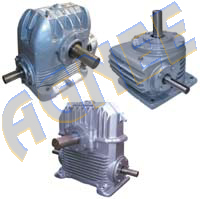 ISO 9001:2008 Enterprise |
|
Special Focus |
| In the News News Index  Agnee Registered as Vendor with Defense Details |
| Agro Engineers (ISO 9001:2008 Enterprise) F-557, Indraprastha Industrial Area, Kota - 324005, Rajasthan, INDIA. Telephone:+91-744-2490773 Contact Us |
 D&B D-U-N-S® Number |
Home | About Us | Contact Us | Complaint | Warranty
|
|
|
||
Gearboxes |
|||
|
|||
| Types of Gearboxes |
|||
|
Gearing Arrangement for Gearbox Gearing arrangement for gearbox includes spur, helical, planetary, bevel, worm, and cycloidal. Bevel gear is a gear wheel meshed with another so that their shafts are at an angle less than 180degrees. They connect intersecting axes. Helical gears connect parallel shafts but the involute teeth are cut at an angle to the axis of rotation. Two mating helical gears must have equal helix angle but opposite hand. Spur gears connect parallel shafts, have involute teeth that are parallel to the shaft and can have internal or external teeth. Planetary gears are a set of gears usually two or more on or inside a larger gear. They make drastic gear ratio possible. They are used when one wishes to turn the input in the same direction as the output. Planetary gearboxes can be designed with gear sets or a set of planetary cones. Cycloidal gears are used in pairs and are set at an angle of 180 degrees used to balance the load and are driven by multiple crank shafts to share the load and increase torsion rigidity. Cycloid reducers use rolling elements and a multilobe cam to transmit torque and provide speed reduction. A worm gear is an inclined plane wrapped around a central axle. It is a gear with one or more teeth in the form of screwed threads. |
|||
|
Controlling Gear Box Contamination Wear and tear is common in gearboxes. Wear commonly occurs as a result of the contamination and degradation of the lubricant. Proactive maintenance is a well-documented concept. It leads to longer life of the gearbox. In a gearbox, there are moving components that transmit power through rotation and so degradation of lubricant can lead to adhesion, abrasion and corrosion of component surfaces, which finally leads to component failure. The oil used for lubrication must be free from contamination. Seals have the ability to seal against oil leakage. Breathers are used for allowing airflow on the gearbox. This is to allow for changes in volume as a result of top-ups, leakage and temperature-related volume changes. An annual check of all switches and sensors should be performed to verify operation as per lubrication system settings. Pumps and other motorized accessories should be checked at scheduled intervals. Flows and pressure drops at the cooler, filters and inlet to the rotating equipment should be routinely monitored and recorded to identify any adverse trends. An annual check of cooler condition is important to maintain cooler efficiency. |
|||
|
|
|

